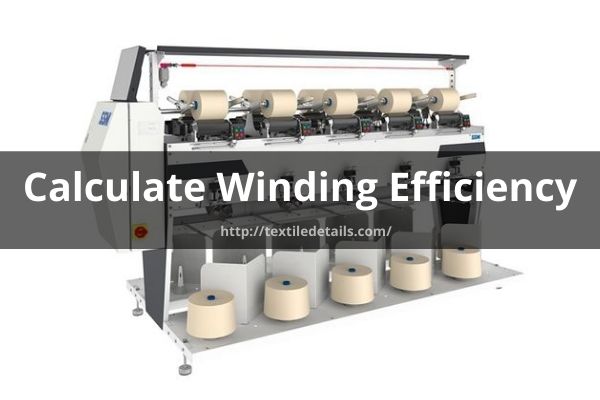Winding:
In the context of textiles, winding is the process of transferring yarn or thread from a larger spool or package onto a smaller one in order to make it more manageable for subsequent processing, such as weaving or knitting. Winding can be done manually or with the use of machines, depending on the volume of thread that needs to be wound.
During the winding process, the thread is passed through a tensioning mechanism to ensure that it is wound evenly and with consistent tension. The thread is then guided onto the smaller spool, which may be a bobbin, cone, or tube, depending on the intended use.
In this article, we will know how to calculate winding efficiency with an example.

Winding Efficiency:
Winding efficiency is a measure of how well a thread or yarn is wound onto a spool during the winding process. It is typically expressed as a percentage and is calculated by comparing the weight of the thread or yarn wound onto the spool to the weight of the thread or yarn that was originally on the larger spool or package.
A higher winding efficiency indicates that more of the original thread or yarn was successfully transferred to the smaller spool, resulting in less waste and more efficient use of the material. A lower winding efficiency may indicate that the thread or yarn was not wound tightly enough, or that there were inconsistencies in the tension or other factors during the winding process.
The ratio of actual production and calculated production is called winding efficiency. It is expressed as a percentage. The efficiency of a highly automated winding operation is calculated by a modification of the mathematical model developed for a similar problem.
………………………………………..Actual Production
Winding Efficiency = ………………………………….. X 100
…………………………………….Calculated Production
How to Calculate Winding Efficiency with Example
Note: If you want to understand this problem then before you must read the following articles.
You may like:
Example:
How long will it take for a winder to wind 3.00 lbs of 16 Ne yarn if the winder operates at 745yd/min with an efficiency of 95%?
We know that,
Time, t = length / speed
= L / V
Here,
L = Length of yarn in the package
Speed, V = 745yd/min.
Weight of the yarn in the package, W =3.00 lbs
Yarn count, Ne = 16
We know that,
……………………………………L × w
Yarn count, Ne = ………………………………..
…………………………………….W × l
……………………………Ne × l × W
Therefore, L = ……………………………
………………………….……..W
…….16 x 3.00 x 840
= ……………………………
………………1
= 40,320 yds
……………..40,320
So, t = …………………..
……………..745
= 54.12 minutes (assuming no breaks or stops)
To consider the effect of efficiency,
……………………….54.12
Therefore, t = ………………
………………………..0.95
= 56.97 minutes
Key Factors of Winding Efficiency:
There are some key factors of winding efficiency which has pointed out in the following:
- Yarn count,
- Yarn quality,
- Capacity utilization,
- Power failure,
- Maintenance and overhauling,
- Worker efficiency,
- Workload per worker,
- Humidity,
- Creeling time,
- Doffing time,
- Spindle of drum speed and so on.
